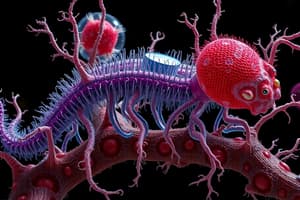Podcast
Questions and Answers
Which of the following is NOT a characteristic of animals?
Which of the following is NOT a characteristic of animals?
- No cell walls
- Autotrophic (correct)
- Heterotrophic
- Multicellular
What defines specialization in cells?
What defines specialization in cells?
Performing a specific function
What is the term for where similar cells connect to form tissues?
What is the term for where similar cells connect to form tissues?
Cell junctions
What do organs consist of?
What do organs consist of?
What forms an organ system?
What forms an organ system?
What is ingestion?
What is ingestion?
What happens during digestion?
What happens during digestion?
What is a zygote?
What is a zygote?
What process does a zygote undergo to form tissues and organs?
What process does a zygote undergo to form tissues and organs?
What is differentiation in cells?
What is differentiation in cells?
What is the nervous system primarily made up of?
What is the nervous system primarily made up of?
What leads to movement in the muscular and nervous systems?
What leads to movement in the muscular and nervous systems?
What are invertebrates characterized by?
What are invertebrates characterized by?
What do chordates possess at some point in their development?
What do chordates possess at some point in their development?
What term refers to identical body arrangement on opposite sides of an axis?
What term refers to identical body arrangement on opposite sides of an axis?
What does cephalization refer to?
What does cephalization refer to?
What are germ layers?
What are germ layers?
What type of circulatory system do vertebrates have?
What type of circulatory system do vertebrates have?
What do hermaphrodites do?
What do hermaphrodites do?
What is direct development in vertebrates?
What is direct development in vertebrates?
What happens during cleavage?
What happens during cleavage?
What is the function of the endoderm?
What is the function of the endoderm?
What is the mesoderm responsible for?
What is the mesoderm responsible for?
Flashcards are hidden until you start studying
Study Notes
Animal Characteristics
- Multicellular organisms that are heterotrophic, consuming food rather than producing it.
- Lack cell walls, distinguishing them from plants and fungi.
- Classified into vertebrates, which possess a backbone, and invertebrates, which do not.
- Reproduce sexually, forming a zygote when haploid cells combine.
Cell Structure and Function
- Specialization allows cells to perform specific functions.
- Cell junctions connect similar cells to form tissues.
- Organs arise from the combination of similar tissues, allowing for specific functions.
- Organ systems are composed of groups of similar organs working together.
Nutrition and Energy
- Ingestion refers to how animals consume complex organic molecules through eating.
- Digestion is the extraction of organic molecules from ingested materials.
Developmental Biology
- A zygote undergoes mitotic division to develop tissues and organs.
- Differentiation transforms mass cells into specialized cells, enabling specific functions.
- Embryonic development involves stages including cleavage, blastula formation, and gastrulation to create germ layers.
Nervous and Muscular Systems
- The nervous system consists of neurons responsible for conducting electrical signals and processing information.
- The muscular system enables movement through muscle contraction stimulated by nerves.
Invertebrate Characteristics
- Invertebrates represent the majority of animal species and exhibit various symmetries like radial or bilateral.
- Simple forms include sponges, whereas complex forms include arthropods like spiders.
- Common body features include segmentation, fluid pressure for support, and varying nervous system complexity.
Chordate Characteristics
- Chordates possess a notochord, dorsal nerve cord, pharyngeal pouches, and a postanal tail at some point in development.
- The notochord develops into the spinal column, while the dorsal nerve cord forms the brain and spinal cord.
- Other structures evolve from the germ layers: endoderm, ectoderm, and mesoderm.
Symmetry and Body Plan
- Body plan describes an organism's shape, symmetry, and internal organization, including anatomical orientation (dorsal, ventral).
- Cephalization is significant in bilaterally symmetrical animals, concentrating sensory organs near the head.
Support Systems
- Invertebrates often rely on an external skeleton or fluid pressure for body support, while vertebrates possess an endoskeleton.
- Body coverings, or integument, protect and maintain moisture.
Circulatory and Respiratory Systems
- Invertebrates may have open circulatory systems, where blood flows freely, while vertebrates have closed systems with blood contained in vessels.
- Gas exchange methods vary: gills for aquatic vertebrates and lungs for terrestrial vertebrates.
Excretory Systems
- Invertebrates typically have digestive tracts and excrete waste primarily as ammonia.
- Vertebrates have complex excretory systems to filter and remove waste.
Reproductive Strategies
- Reproduction can occur via asexual means in hermaphrodites or through direct and indirect development stages.
- Fertilization methods vary: external in aquatic species and internal in many terrestrial species.
Cell Types and Division
- Sperm and egg cells contain a haploid number of chromosomes; sperm are motile while eggs provide nourishment during early development.
- Cleavage increases cell quantity without size growth initially, leading to the hollow blastula stage.
- Gastrulation results in a multilayered embryo with distinct germ layers for further organ formation.
Germ Layers and Their Functions
- Endoderm: develops into internal organs.
- Ectoderm: forms skin, nails, hair, and the nervous system.
- Mesoderm: creates muscles, the skeleton, and systems like circulation.
Studying That Suits You
Use AI to generate personalized quizzes and flashcards to suit your learning preferences.




